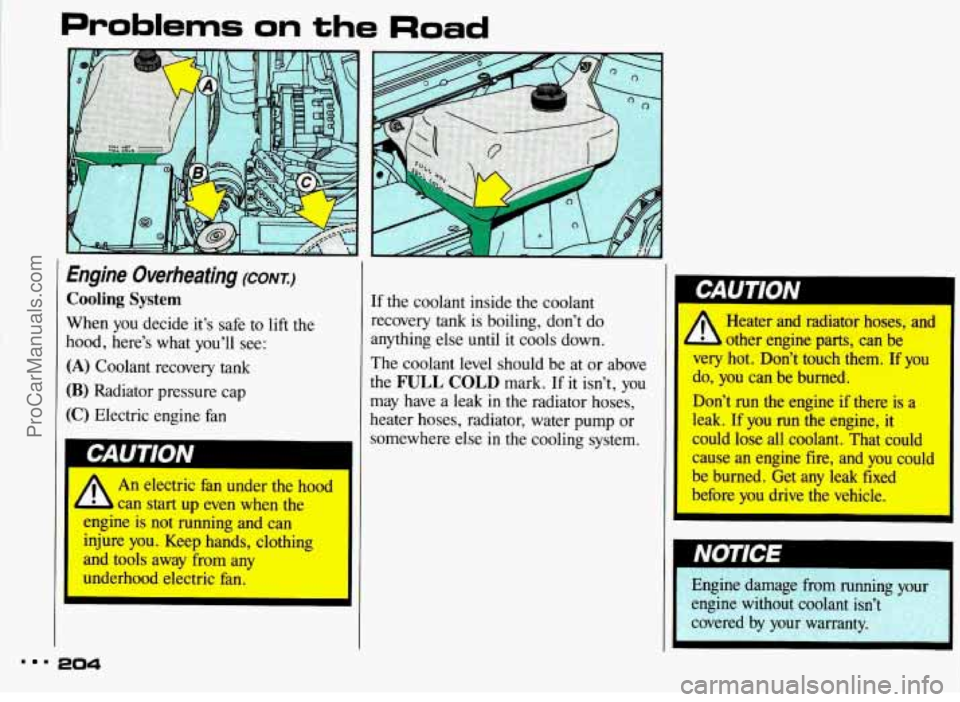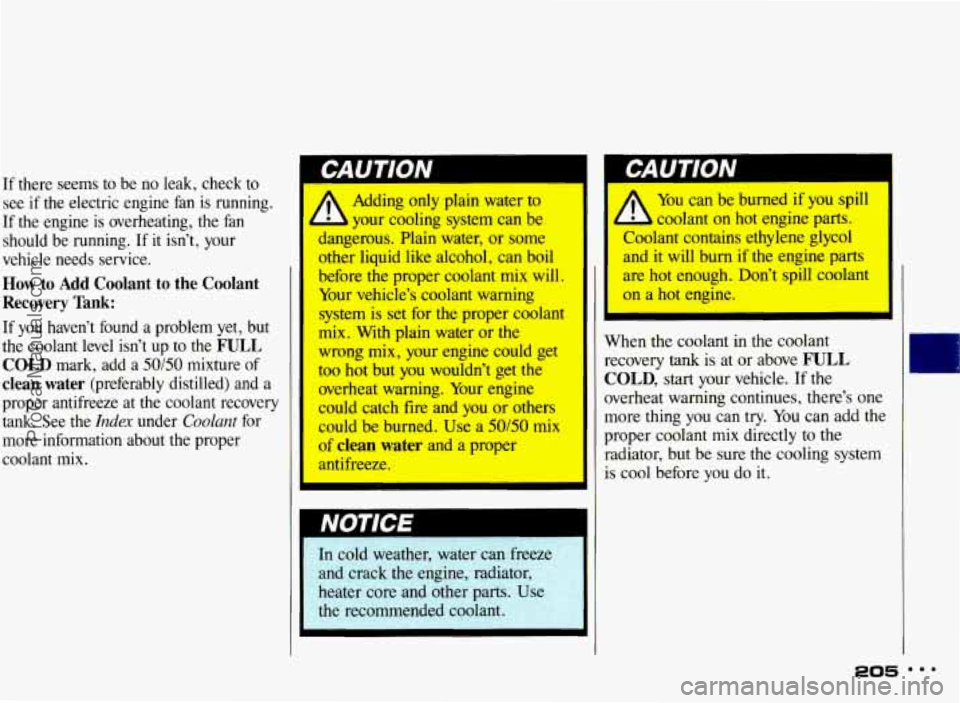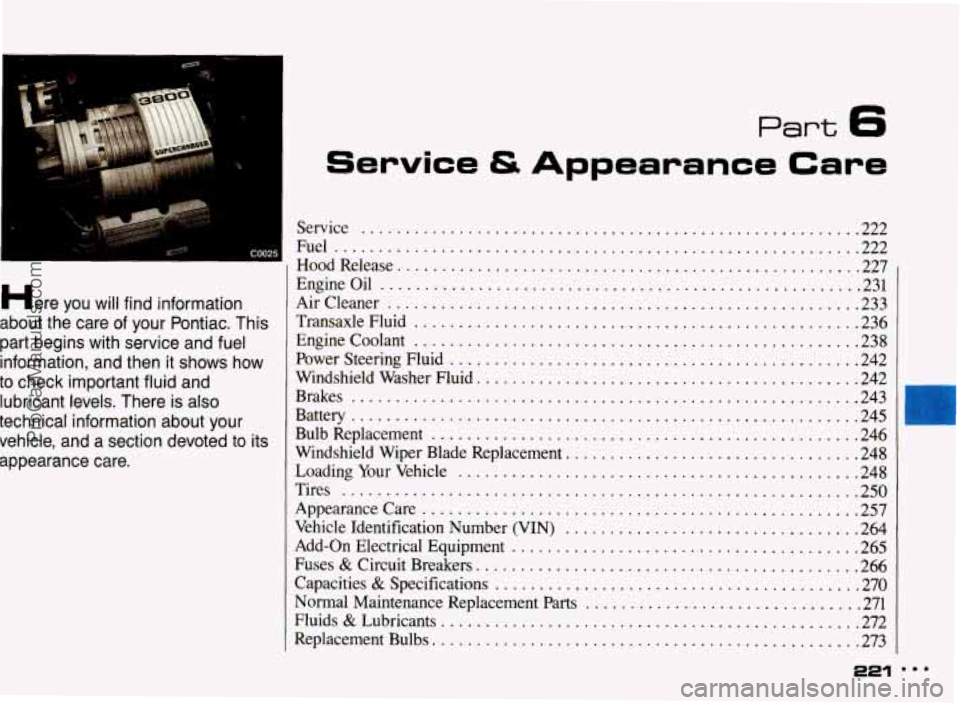Page 205 of 322

Problems on the Road
Engine Overheating (CONK)
Cooling System
When you decide it’s safe to
lift the
hood, here’s what you’ll see:
(A) Coolant recovery tank
(B) Radiator pressure cap
(C) Electric engine fan
An
electric fan under the hood
h can start up even when the
engine is not running and can
injure
you. Keep hands, clothing
and tools away from any
underhood electric fan.
If the coolant inside the coolant
recovery tank is boiling, don’t do
anything else
until it cools down.
The coolant level should be at or above
the
FULL COLD mark. If it isn’t, you
may have a leak
in the radiator hoses,
heater hoses, radiator, water pump or
somewhere else
in the cooling system.
I I 1 Heater and radiator hoses, anc
- other engine parts, can be
very hot. Don’t touch them.
If you
do, you can be burned.
Don’t run the engine if there is a
leak.
If you run the engine, it
could lose all coolant. That could
cause an engine fire, and you could
be burned. Get any leak fixed
before you drive the vehicle.
I
Engine damage from running your
engine without coolant isn’t
covered by your warranty.
.. . 204
ProCarManuals.com
Page 206 of 322

should be running. If it isn’t, your
vehicle needs service.
How
to Add Coolant to the Coolant
Recovery Tank:
If you haven’t found a problem yet, but
the coolant level isn’t up to the
FULL
COLD mark, add a 50/50 mixture of
clean water (preferably distilled) and a
proper antifreeze at the coolant recovery
tank. See the Index under Coolant for
more information about the proper
coolant mix.
I b-Au I IUN If there seems to be no leak, check to
see
if the electric engine fan is running. Adding only plain water to
If the engine is overheating, the fan L your cooling system can be
dangerous. Plain water, or some
other liquid like alcohol, can boil
before the proper coolant
mix will.
Your vehicle’s coolant
warning
,k L
You can be burned if you spill
coolant on
hot engine parts.
Coolant contains ethylene glycol
and it will burn if the engine parts
are
hot enough. Don’t spill coolant
on a hot engine.
system is set for the proper coolant
I
mix. With plain water or the
too hot but you wouldn’t get the
overheat warning. Your engine
could catch fm and you or others
be Use a mix
of clean water and a proper
antifreeze. When
the coolant in the coolant
COLD, start your vehicle. If the
overheat warning continues, there’s one
proper coolant mix directly
to the
more
thing you can try. You can add the
radiator, but be sure the cooling system
is cool before
you do it.
wrong
mix, Your
engine could get recovery tank is at or above FULL
I
In cold weather, water can freeze II
and crack the engine, radiator,
heater core and other
parts. Use
the recommended coolant.
I
r
205 ”
ProCarManuals.com
Page 207 of 322
Problems on the Road
i '. 'k
I Engine Overheating (CONT.)
Steam and scalding liquids
From a hot cooling system can
3w out and burn you badly. They
ale under pressure, and if you turn
I thl= radiator pressure cap-even a
tle-they can come out at high
I eed. Never turn the pressure cap
when the cooling system, including
the radiator pressure cap,
is hot.
Wait for the cooling system and
radiator pressure cap to cool if you
ever have to turn. the pressure cap.
How to Add Coolant to the Radiator:
1. You can remove the radiator pressure
cap when the cooling system,
including the radiator pressure cap
and upper radiator hose, is no longer
hot. Turn the pressure cap slowly to
the left
until it first stops. (Don't
press down while turning the
pressure cap.)
If you hear a hiss, wait for that to stop.
A hiss means there is still some pressure
left.
2. Then keep turning the pressure cap,
but now push down as you turn it.
Remove the pressure cap.
ProCarManuals.com
Page 208 of 322
3. Fill the radiator with the proper mix,
up to the base of the filler neck.
4. Then fill the coolant recovery tank to 5. Put the cap back on the coolant
I the FULL COLD mark. recovery
tank, but leave the radiator
pressure cap off.
207 '.
ProCarManuals.com
Page 209 of 322

Problems on the Road
I Engine Overheating (CONT.)
6. Start the engine and let it run until
you can feel the upper radiator hose
getting hot. Watch out for the engine
fan.
7. By this time, the coolant level inside
the radiator filler neck may be lower.
If the level is lower, add more of the
proper mix through the filler neck
until the level reaches the base of the
filler neck.
8. Then replace the pressure cap. Be
sure the arrows on the pressure cap
line up like this.
Ifa Tire Goes Flat
It’s unusual for a tire to “blow out”
while you’re driving, especially if you
maintain your tires properly. If air goes
out of a tire, it’s much more likely to
leak out slowly. But
if you should ever 1
have a “blowout:’ here are a few tips
about what to expect and what to do:
If a front tire fails, the flat tire will
create a drag that pulls
the vehicle
toward that side. Take your foot off the accelerator pedal and grip the steering
wheel firmly. Steer
to maintain lane
position,
then gently brake to a stop well
out of the traffic lane.
ProCarManuals.com
Page 222 of 322

Part 6
I .
COO25
Here you will find information
about the care of your Pontiac
. This
part begins with service and fuel
information. and then it
shows how
to check important fluid and
lubricant levels
. There is also
technical information about your
vehicle. and
a section devoted to its
appearance care
.
Service G Appearance Care
Service ............................. .................. 222
Fuel
......................................................... 222
Engineoil
...................................................... 231
HoodRelease
.................................................... 227
Aircleaner
..................................................... 233
TransaxleFluid
.................................................. 236
Enginecoolant
.................................................. 238
Power Steering Fluid
.............................................. 242
Windshield Washer Fluid
........................................... 242
Bulb Replacement
.............................................. 246
Loading Your Vehicle
............................................. 248
Appearance Care
................................................. 257
Vehicle Identification Number (VIN)
................................. 264
Add-on Electrical Equipment
....................................... 265
Fuses
& Circuit Breakers ........................................... 266
Capacities
& Specifications ......................................... 270
Normal Maintenance Replacement Parts
............................... 271
Fluids
& Lubricants ............................................... 272
Replacement Bulbs
................................................ 273
Brakes
......................................................... 243
Battery
.......................................................... 245
Windshield Wiper Blade Replacement
...................... ....... 248
Tires
.......................................................... 250
221 ...
ProCarManuals.com
Page 230 of 322
3800 Engine (CODE L)
When you open the hood, you’ll see:
1. Engine Coolant Recovery Tank
2. Power Steering Fluid Reservoir
3. Automatic Transaxle Fluid Dipstick
4. Brake Fluid Reservoir
5. Windshield Washer Fluid Reservoir
6. Air Cleaner
7. Engine Oil Dipstick
8. Engine Oil Fill Cap
9. Radiator Pressure Cap
1 0. Battery
229
ProCarManuals.com
Page 231 of 322
Service & Appearance Care
. ... .. . 3800 SC Engine (CODE I)
When you open the hood, you'll see:
1. Engine Coolant Recovery Tank
2. Automatic Transaxle Fluid Dipstick
3. Power Steering Fluid Reservoir
4. Brake Fluid Reservoir
5. Windshield Washer Fluid Reservoir
6. Air Cleaner
7. Engine Oil Dipstick
8. Engine Oil Fill Cap
9. Radiator Pressure Cap
1 0. Battery
ProCarManuals.com